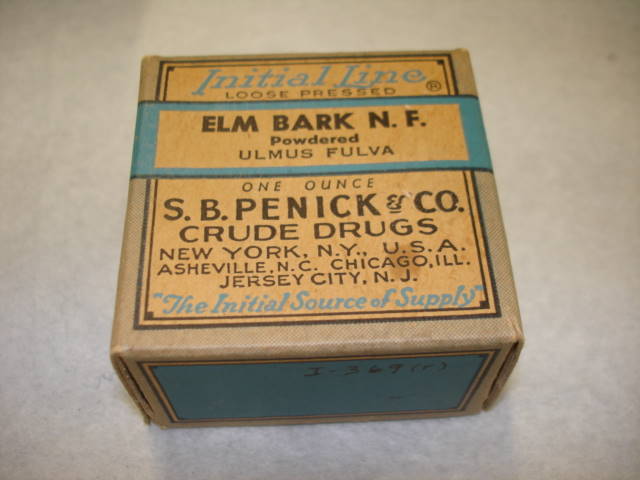The history behind the S.B. Penick & Company, that produced this apothecary box of Elm Bark Powder, is a perfect example of the innovative use of resources produced by the environment of the United States. Slippery Elm Bark was used to make tea from to sooth a sore mouth or other common internal ailments. Slippery Elm Bark gets its name for the inner layer of the tree bark being so slippery. This tree can be found in parts of the Northeast, along the east coast and even into parts of central Texas. S.B Penick came out of modest beginnings collecting and gathering botanicals for herbal remedies from the woods and fields of his Southeastern home. Long before professional doctors, hospitals and drug stores in the United States remedies were made from resources found in nature and administered by a family member, local medicine man or an appointed town physician. Peddlers known as ‘herb doctors’ would sell plants and herbs to settlements to cure everything from internal ailments to common cuts and bruises.
S.B Penick was more of an ‘herb doctor’ until World War I when his skills at producing remedies from plants were needed more than ever. Thus, S.B Penick & Company was founded. S.B. Penick used the plants supplied by his environment to produce botanical pharmaceuticals, medicine made from plants. This company would grow to be one of the largest botanical pharmaceutical producing companies by the 1960s. Unfortunately for the S.B Penick Company, botanical pharmaceuticals had been on a steady decline over the years after the Food and Drug Act was established in 1906, putting into question herbal remedies. It took time for this act to spread to the masses but it did so through trained doctors questioning the effectiveness of the herbal remedies.
With a declining market for their products, the S.B. Penick & Company would go out of business along with much of the botanical pharmaceutical industry. The decline was not only because natural plant based medicines were not working but also they were just not as profitable as the newer chemical medicines. The company was split apart for assets with only Penick Pharmaceuticals remaining and being bought in 1988. This portion of the company survived because it kept working and changing with the times, focusing on inorganic medicines that were being used and purchased more by hospitals and doctor’s offices. Further hardships would fall upon the company when they had to file for bankruptcy in 1994 but the Penick name and the use of plants and other natural resources, like Slippery Elm Bark, continues to be used in the United States to this day.
It seems remarkable that such a small box of an all-natural medical remedy could tell such a big story, but it’s the story behind these seemingly simple items that can stir our memories and ignite our imaginations. This paper and ink box of Elmwood bark beckons us to consider our earliest days of exploring our environment’s resources. Challenge yourselves to imagine the possibilities in the simplest things, you’d be surprised what you may learn.
